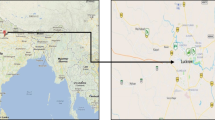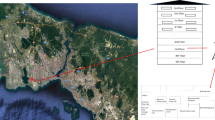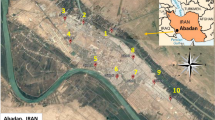Abstract
Particulate matter (PM), a major component of air pollution, is an important carrier medium of various chemical and microbial compounds. Air pollution due to PM could increase the level of bacteria and associated adverse health effects. Staphylococci as important opportunistic pathogens that cause hospital- and community-acquired infections may transmit through air. This study aimed to obtain knowledge about the concentration of airborne bacteria as well as staphylococci associated with particulate matter with a diameter of less than 2.5 micrometers (PM2.5) in ambient air. The impact of meteorological factors including ultraviolet (UV) index, wind speed, temperature, and moisture on microbial concentrations was also investigated. Quartz filters were used to collect PM2.5 and associated bacteria in ambient air of a semiarid area. Airborne bacteria were quantified by culture method and Staphylococcus species identified by molecular methods. The mean (SD) concentration of PM2.5 and airborne bacteria was 64.83 (24.87) µg/m3 and 38 (36) colony forming unit (CFU)/m3, respectively. The results showed no significant correlation between the levels of PM2.5 and concentrations of bacteria (p < 0.05). Staphylococcus species were detected in 8 of 37 (22%) samples in a concentration from 3 to 213 CFU/m3. S. epidermidis was detected with the highest frequency followed by S. gallinarum and S. hominis, but S. aureus and methicillin-resistant Staphylococcus aureus (MRSA) were not detected. No significant correlation between the concentrations of bacteria with meteorological parameters was observed (p < 0.05). Our finding showed that, although the study area is sometimes subject to air pollution from PM2.5, the concentration of PM2.5- associated bacteria is relatively low. According to the results, PM2.5 may not be a source of community-associated staphylococcal infections.



Similar content being viewed by others
References
Abulreesh H, Organji S. The prevalence of multidrug-resistant staphylococci in food and the environment of Makkah, Saudi Arabia. Res J Microbiol. 2011;6(6):510–23.
Beggs C. The airborne transmission of infection in hospital buildings: fact or fiction? Indoor Built Environ. 2003;12(1–2):9–18.
Madsen AM, Moslehi-Jenabian S, Islam MZ, Frankel M, Spilak M, Frederiksen MW. Concentrations of Staphylococcus species in indoor air as associated with other bacteria, season, relative humidity, air change rate, and S. aureus-positive occupants. Environ Res. 2018;160:282–91.
Calfee DP, Salgado CD, Milstone AM, Harris AD, Kuhar DT, Moody J, et al. Strategies to prevent methicillin-resistant staphylococcus aureus transmission and infection in acute care hospitals: 2014 update. Infect Control Hosp Epidemiol. 2016;35(S2):S108–S132.
Becker K, Heilmann C, Peters G. Coagulase-negative staphylococci. Clin Microbiol Rev. 2014;27(4):870–926.
Madsen AM, Kurdi I, Feld L, Tendal K. Airborne MRSA and total staphylococcus aureus as associated with particles of different sizes on pig farms. Ann Work Expo Health. 2018;62(8):966–77.
Faridi S, Naddafi K, Kashani H, Nabizadeh R, Alimohammadi M, Momeniha F, et al. Bioaerosol exposure and circulating biomarkers in a panel of elderly subjects and healthy young adults. Sci Total Environ. 2017;593–594:380–9.
Aziz AA, Lee K, Park B, Park H, Park K, Choi I-G, et al. Comparative study of the airborne microbial communities and their functional composition in fine particulate matter (PM2. 5) under non-extreme and extreme PM2. 5 conditions. Atmos Environ. 2018;194:82–92.
Shamsipour M, Hassanvand MS, Gohari K, Yunesian M, Fotouhi A, Naddafi K, et al. National and sub-national exposure to ambient fine particulate matter (PM2. 5) and its attributable burden of disease in Iran from 1990 to 2016. Environ Pollut. 2019;255:113173.
Xu C, Wei M, Chen J, Zhu C, Li J, Xu X, et al. Profile of inhalable bacteria in PM2. 5 at Mt. Tai, China: Abundance, community, and influence of air mass trajectories. Ecotoxicol Environ Saf. 2019;168:110–9.
Hadei M, Nazari SSH, Yarahmadi M, Kermani M, Farhadi M, Shahsavani A. Estimation of gender-specific lung cancer deaths due to exposure to PM2. 5 in 10 cities of Iran during 2013–2016: A modeling approach. Int J Cancer Manag. 2013;10(8):1–8.
Goudarzi G, Shirmardi M, Naimabadi A, Ghadiri A, Sajedifar J. Chemical and organic characteristics of PM2. 5 particles and their in-vitro cytotoxic effects on lung cells: The Middle East dust storms in Ahvaz, Iran. Sci Total Environ. 2019;655:434–45.
Polymenakou PN, Mandalakis M, Stephanou EG, Tselepides A. Particle size distribution of airborne microorganisms and pathogens during an intense African dust event in the eastern Mediterranean. Environ Health Perspect. 2007;116(3):292–6.
Hussey SJ, Purves J, Allcock N, Fernandes VE, Monks PS, Ketley JM, et al. Air pollution alters Staphylococcus aureus and Streptococcus pneumoniae biofilms, antibiotic tolerance and colonisation. Environ Microbiol. 2017;19(5):1868–80.
Karanasiou A, Moreno N, Moreno T, Viana M, De Leeuw F, Querol X. Health effects from Sahara dust episodes in Europe: literature review and research gaps. Environ Int. 2012;47:107–14.
Shamsizadeh Z, Nikaeen M, Esfahani BN, Mirhoseini SH, Hatamzadeh M, Hassanzadeh A. Detection of antibiotic resistant Acinetobacter baumannii in various hospital environments: potential sources for transmission of Acinetobacter infections. Environ Health Prev Med. 2017;22(1):44.
Noguchi N, Suwa J, Narui K, Sasatsu M, Ito T, Hiramatsu K, et al. Susceptibilities to antiseptic agents and distribution of antiseptic-resistance genes qacA/B and smr of methicillin-resistant Staphylococcus aureus isolated in Asia during 1998 and 1999. J Med Microbiol. 2005;54(6):557–65.
Brakstad OG, Aasbakk K, Maeland JA. Detection of Staphylococcus aureus by polymerase chain reaction amplification of the nuc gene. J Clin Microbiol. 1992;30(7):1654–60.
Zhang K, McClure J-A, Elsayed S, Louie T, Conly JM. Novel multiplex PCR assay for characterization and concomitant subtyping of staphylococcal cassette chromosome mec types I to V in methicillin-resistant Staphylococcus aureus. J Clin Microbiol. 2005;43(10):5026–33.
Baghal Asghari F, Nikaeen M, Mirhendi H. Rapid monitoring of Pseudomonas aeruginosa in hospital water systems: a key priority in prevention of nosocomial infection. FEMS Microbiol Lett. 2013;343(1):77–81.
World Health Organization. Air quality guidelines: global update 2005: particulate matter, ozone, nitrogen dioxide, and sulfur dioxide. World Health Organization; 2006.
Alghamdi MA, Shamy M, Redal MA, Khoder M, Awad AH, Elserougy S. Microorganisms associated particulate matter: a preliminary study. Sci Total Environ. 2014;479:109–16.
Psoter KJ, De Roos AJ, Wakefield J, Mayer JD, Rosenfeld M. Air pollution exposure is associated with MRSA acquisition in young US children with cystic fibrosis. BMC Pulm Med. 2017;17(1):106.
Qin T, Zhang F, Zhou H, Ren H, Du Y, Liang S, et al. High-Level PM2.5/PM10 Exposure is associated with alterations in the human pharyngeal microbiota composition. Front Microbiol. 2019;10(54).
Fang Z, Ouyang Z, Zheng H, Wang X, Hu L. Culturable airborne bacteria in outdoor environments in Beijing,China. Microb Ecol. 2007;54(3):487–96.
Fang Z, Yao W, Lou X, Hao C, Gong C, Ouyang Z. Profile and characteristics of culturable airborne bacteria in hangzhou, Southeast of China. Aerosol Air Quality Res. 2016;16(7):1690–700.
Jeon EM, Kim HJ, Jung K, Kim JH, Kim MY, Kim YP, et al. Impact of Asian dust events on airborne bacterial community assessed by molecular analyses. Atmos Environ. 2011;45(25):4313–21.
Ghosh B, Lal H, Srivastava A. Review of bioaerosols in indoor environment with special reference to sampling, analysis and control mechanisms. Environ Int. 2015;85:254–72.
Du P, Du R, Ren W, Lu Z, Fu P. Seasonal variation characteristic of inhalable microbial communities in PM2. 5 in Beijing city, China. Sci Total Environ. 2018;610:308–15.
Lu R, Li Y, Li W, Xie Z, Fan C, Liu P, et al. Bacterial community structure in atmospheric particulate matters of different sizes during the haze days in Xi’an, China. Sci Total Environ. 2018;637:244–52.
Mirhoseini SH, Nikaeen M, Satoh K, Makimura K. Assessment of airborne particles in indoor environments: Applicability of particle counting for prediction of bioaerosol concentrations. Aerosol Air Qual Res. 2016;16(8):1903–10.
Mirhoseini SH, Nikaeen M, Shamsizadeh Z, Khanahmad H. Hospital air: A potential route for transmission of infections caused by β-lactam–resistant bacteria. Am J Infect Control. 2016;44(8):898–904.
Sivri N, Bağcıgil AF, Metiner K, Şeker DZ, Orak S, Durak SG, et al. Culturable airborne bacteria and isolation of methicillin-resistant coagulase-negative staphylococci from outdoor environments on European side of Istanbul, Turkey. Arch Environ Prot. 2016;42(3):77–86.
Perez H, Michael K, Burstyn I. Airborne Methicillin-Resistant Staphylococcus aureus in Homes. Trends Microbiol. 2012;9:486–93.
Moon KW, Huh EH, Jeong HC. Seasonal evaluation of bioaerosols from indoor air of residential apartments within the metropolitan area in South Korea. Environ Monit Assess. 2014;186(4):2111–20.
Gao M, Yan X, Qiu T, Han M, Wang X. Variation of correlations between factors and culturable airborne bacteria and fungi. Atmos Environ. 2016;128:10–9.
Funding
This research was supported by the Vice Chancellery for Research at the Isfahan University of Medical Sciences (Grant No 197050).
Author information
Authors and Affiliations
Corresponding author
Ethics declarations
Conflict of interest
The authors declare that they have no conflict of interest.
Additional information
Publisher’s note
Springer Nature remains neutral with regard to jurisdictional claims in published maps and institutional affiliations.
Rights and permissions
About this article
Cite this article
Karimi, H., Nikaeen, M., Gholipour, S. et al. PM2.5-associated bacteria in ambient air: Is PM2.5 exposure associated with the acquisition of community-acquired staphylococcal infections?. J Environ Health Sci Engineer 18, 1007–1013 (2020). https://doi.org/10.1007/s40201-020-00522-8
Received:
Accepted:
Published:
Issue Date:
DOI: https://doi.org/10.1007/s40201-020-00522-8




